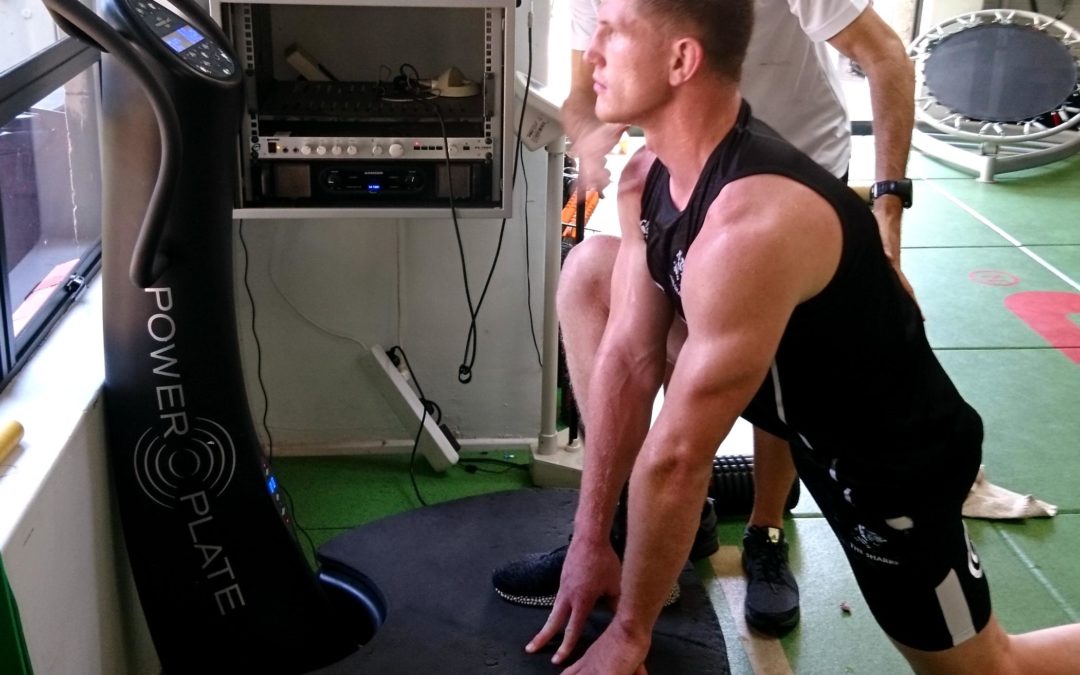
19/09/2018 | All news, Athletes, Strength and Conditioining
Durban – by Dave Macleod. As they continue their challenge for the Currie Cup title in 2018 the Cell C Sharks players are working with lead biokineticist Jimmy Wright to harness 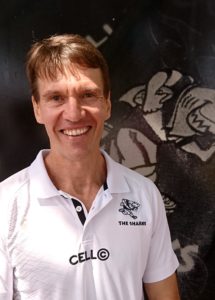 technology to keep themselves prepared for the physical demands of the competition.
technology to keep themselves prepared for the physical demands of the competition.
Keeping up with the latest trends in preparation, performance and recovery are things, that Wright says, the new generation of players are all embracing as part of their professional approach to managing their careers.
Wright is a passionate believer in using technology like the Power Plate vibration technology to optimise training and preparation, and says once the benefits become obvious, players make use of the equipment as a fixed part of their training routine.
“It is all about the one percenters,” says Wright. “At this level it is those one percenters that make all the difference.”
Wright cited an example of a player that battled to get full leg flexibility due to fascia tightness. A few minutes on the Power Plate released that tightness and for the first time the player was touching his toes.
“We want to make sure there is transfer from the gym to the rugby field,” explained Wright. “Every exercise has to be supportive to what happens on the rugby field and increase resilience to possible injury.
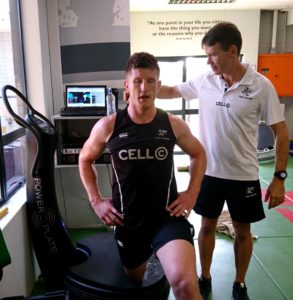 “When it comes to using technology like the Power Plate we achieve major gains by showing the players ways to improve their tissue quality, joint range of movement and how to activate muscles.
“When it comes to using technology like the Power Plate we achieve major gains by showing the players ways to improve their tissue quality, joint range of movement and how to activate muscles.
“When players buy into innovation and better ways of training, our jobs become easier. Instead of spoon-feeding a player by putting up a programme for them, we teach the players how their bodies work and why their bodies respond the way they do.
“Player longevity is all about not getting injured. The players naturally want to buy into that and Power Plate helps us with that,” he said.
Wright said that the vibration technology benefits start with improved mobility.
“What we are trying to achieve with any training programme is to bring stability to movement.
“Rugby challenges stability. We divide the body into three major pillars – the core, the hip and the shoulder – if we work at improving stability in those pillars, then we see movement happening more efficiently on the field and running happens faster and the risk of injury is reduced.
“But at the same time we want to make sure the joints remain flexible. Training can result in joints locking up because training muscles can shorten a joint’s movement capacity,” he said.
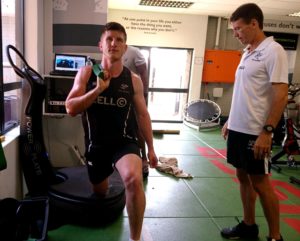
“We can identify the muscles that shorten and the Power Plate helps to maintain full range of movement in the joint.
“For example, locks often battle with tight muscles because they have long levers and tight hamstrings, and they find it difficult to achieve better hip range” he said.
“We use a two minute Power Plate routine at a low frequency that releases the fascial system top improve hip joint range of movement.
“When a player physically sees that, they immediately buy into it
Wright said the technology was rewriting the ways athletes warm up before training and competition.
“”The old ways of warming up have changed. These days we like to spend the first thirty minutes before a field session indoors,” he explained.
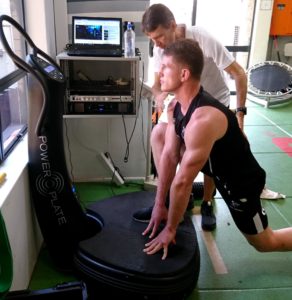
“We get the players’ shoes off to activate the fascial lines, starting at the bottom of the foot to the top of the head.
“Part of that is done on the Power Plate, together with specific additional movements, each with a particular pre-habilitative purpose.
“We don’t talk about rehab, rather we say a player is “in training in the presence of an injury”. It’s a totally different approach because there are more things that work in the body than those that don’t! Injured players still train. They train very hard, but a little differently to the guys that are playing on Saturday.”
Wright said that the new generation of professional rugby players coming through the ranks were harnessing the advantages of technology like the Power Plate vibration systems to enhance their abilities and prolong their careers.
“It is making our jobs easier and the benefits start to become obvious to the athletes,” he added.
For more information visit www.powerplate.co.za
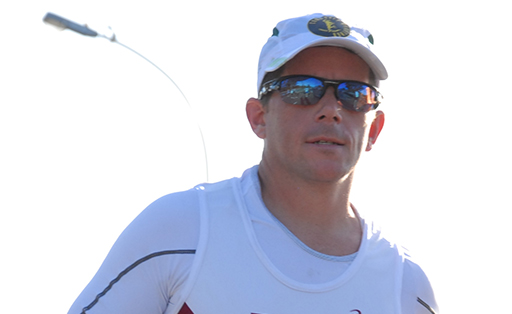
04/04/2018 | All news, Athletes, Running, Strength and Conditioining
March in South Africa is the month when many of the big endurance events occur nationally as well as many of the school sports festivals. There is the Cape Town Cycle Tour, the Cape Epic and the Two Oceans Ultra Marathon and then of course, the Easter Rugby festivals.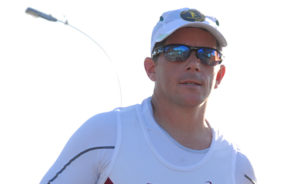
One of my clients/athletes competed in the master’s category of the Cape Epic Cycle and much of his strength and mobility work was done incorporating the Power Plate. In terms of flexibility and strength imbalances, what he initially presented with was typical of cyclists: kyphosis; weak glutes and hamstrings. He lacked flexibility through his posterior kinetic chain and his balance and proprioception was not good at all. (This is problematic for a mountain biker in very technical terrain.)
I changed his program so that all of the workout preparation was done on the Power Plate- stretching, balance and potentiation of the exercises we were going to do that day. Once the specific strength work was done, I put him back on the PP to recover.
He finished the race yesterday and said that his off the bike conditioning played a massive role in his performance. (Loves the PP, by the way).
I also introduced some 13 year old boys to the recover component on the PP- hamstring flexibility at this age is shocking to say the least. Besides the ‘novelty’ of being on a ‘fancy’ piece of equipment, they were amazed at the rapid improvement in flexibility.
The cherry on top of this month’s events was the opportunity to attend the ‘RUN INJURY FREE’ workshop by Dr Emily Splichal. This incorporated PP and Naboso Barefoot Technology. To say that this workshop was impressive would be an understatement and all the delegates, myself included, rated this as one of the best they had attended.
The beauty of it was that it showed yet again how PP can be integrated into all aspects of training and that the technology is aligned with other systems, like Naboso. Keep watching the Power Plate media platforms to see when Dr Emily will be back.
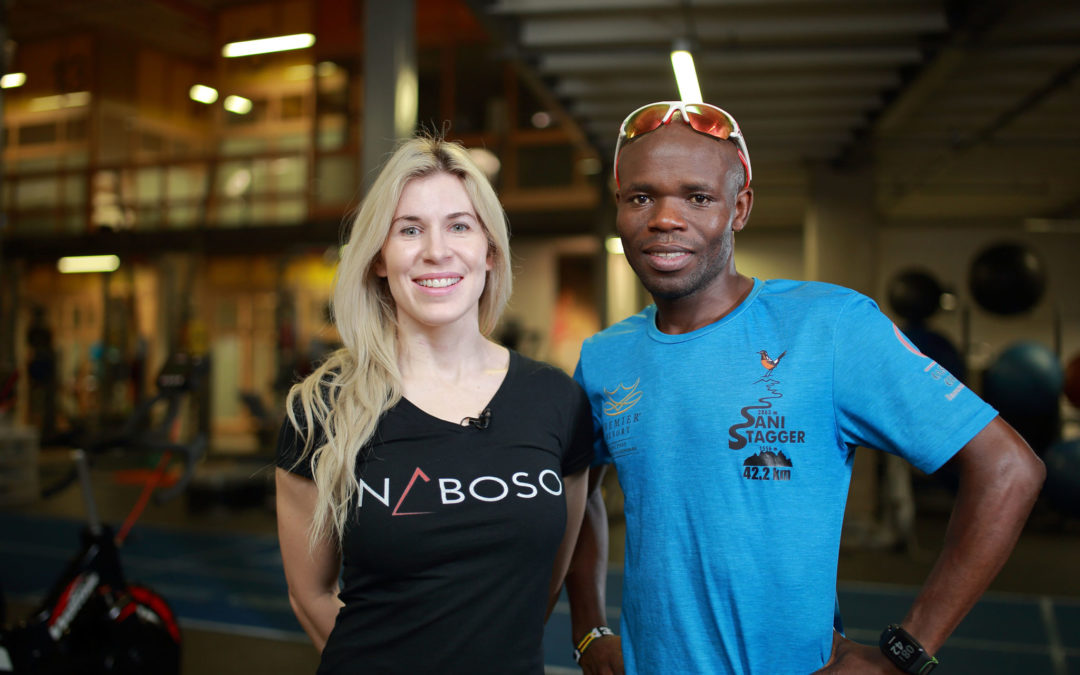
23/03/2018 | All news, Athletes, Strength and Conditioining
As South Africans approach the ultra-distance marathon season, starting with the Old Mutual Two Oceans next weekend, the Run Injury Free programme in conjunction with Power Plate gives runners the tools to prepare, compete and recover knowing that they are going to remain injury free.
New York-based Dr Emily Splichal is currently in South Africa heading around the country with the Run Injury Free Programme, educating biokineticists, trainers, coaches, and runners about how it works and how the Power Plate is such an integral part of the process.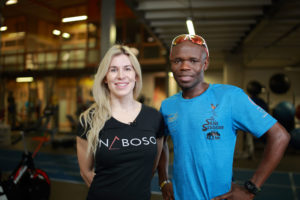
“To date most running programs focus on biomechanics and technique, however very few are looking at these injuries as how they related to neuromuscular control,” Dr Splichal said. “The Run Injury Free Programme by Power Plate and Naboso Technology is the answer to preventing running injuries from a neuromuscular perspective.
“Naboso Technology has partnered with Power Plate to bring a new approach and perspective on running-related injuries.
“70 – 80% of runners will get injured at some point during their running career which means the prevention of injury is critical in this population.”
The Run Injury Free Programme is being launched around the country as runners gear up for the upcoming Two Oceans and Comrades Marathons. The most important element of the programme is that it is not specifically aimed at elite athletes.
“All runners regardless of fitness level or running distance will benefit from the Run Injury Free Programme,” Dr Splichal stressed. “All runners require the same stabilization and neuromuscular coordination to meet the repetitive impact of running.
“In fact, all movement, including walking and jumping have similar demands on the neuromuscular system which means this program would benefit not just runners.”
Power Plate hinges on three major components, prepare, perform, recover. The Run Injury Free Programme too follows the same principals.
“Run Injury Free is our way to help runners, number one, better understand the demands of running, number two, better prepare their body to meet these demands and, number three, more effectively recover to offset stress and injury risk.
“It includes our pre-run prepare section which is done before the runners put on their shoes and start running, the post-run recovery which is intended to more effectively reduce the stress associated with running.
“Then the two workouts that challenge the stabilization and muscle activation demands of running and finally, the recovery core flow to focus on increased core strength and total body flexibility needed for running,” she explained.

22/02/2018 | All news, Fitness, Strength and Conditioining
The utilization of Power Plate in the training environment brings with it a number of mixed signals from the gym members.
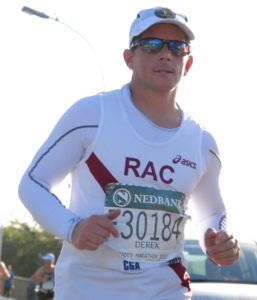 There are those that utilized it when it first came onto the market, but were never really educated on how to use it. There are those that have never been near the Power Plate because they thought it was more of a gimmick than a medical grade training instrument. Finally, there are those who have never seen it before.
There are those that utilized it when it first came onto the market, but were never really educated on how to use it. There are those that have never been near the Power Plate because they thought it was more of a gimmick than a medical grade training instrument. Finally, there are those who have never seen it before.
I encountered all three of these in our facility and realized it wasn’t necessary to have three different approaches. It was more simple and effective to do the ‘First Impression Demonstration’ and the WOW program.
Being able to give a thorough explanation, including the physiological systems effected by Power Plate utilization, was sufficient to get everyone on to the same page – or to the point where they wanted to know more and try more.
Also, the fact that the new approach is about integration into existing training programs/systems, and not just about replacing them, made it more appealing. (Considering that people are scared of change, an integrated approach is less intimidating)
Enter the arena: Prepare – Perform – Recover.
Based on my clients’ individual needs, I introduced the Power Plate into their workouts – starting with their Dynamic stretching and movement preparation.
Needless to say, the subsequent improvement in mobility and muscle activation was hugely noticeable. For some exercises, I moved back to the Power plate for the potentiation of the movement and there was an increase in movement efficiency and in the load used.
Thoughts going forward: Education and experience will improve the number of people willing to try the Power Plate.
Derek Archer
Director of Education
B.A Human Movement Sciences
FITPRO- Institute of Fitness Professionals

 technology to keep themselves prepared for the physical demands of the competition.
technology to keep themselves prepared for the physical demands of the competition. “When it comes to using technology like the Power Plate we achieve major gains by showing the players ways to improve their tissue quality, joint range of movement and how to activate muscles.
“When it comes to using technology like the Power Plate we achieve major gains by showing the players ways to improve their tissue quality, joint range of movement and how to activate muscles.

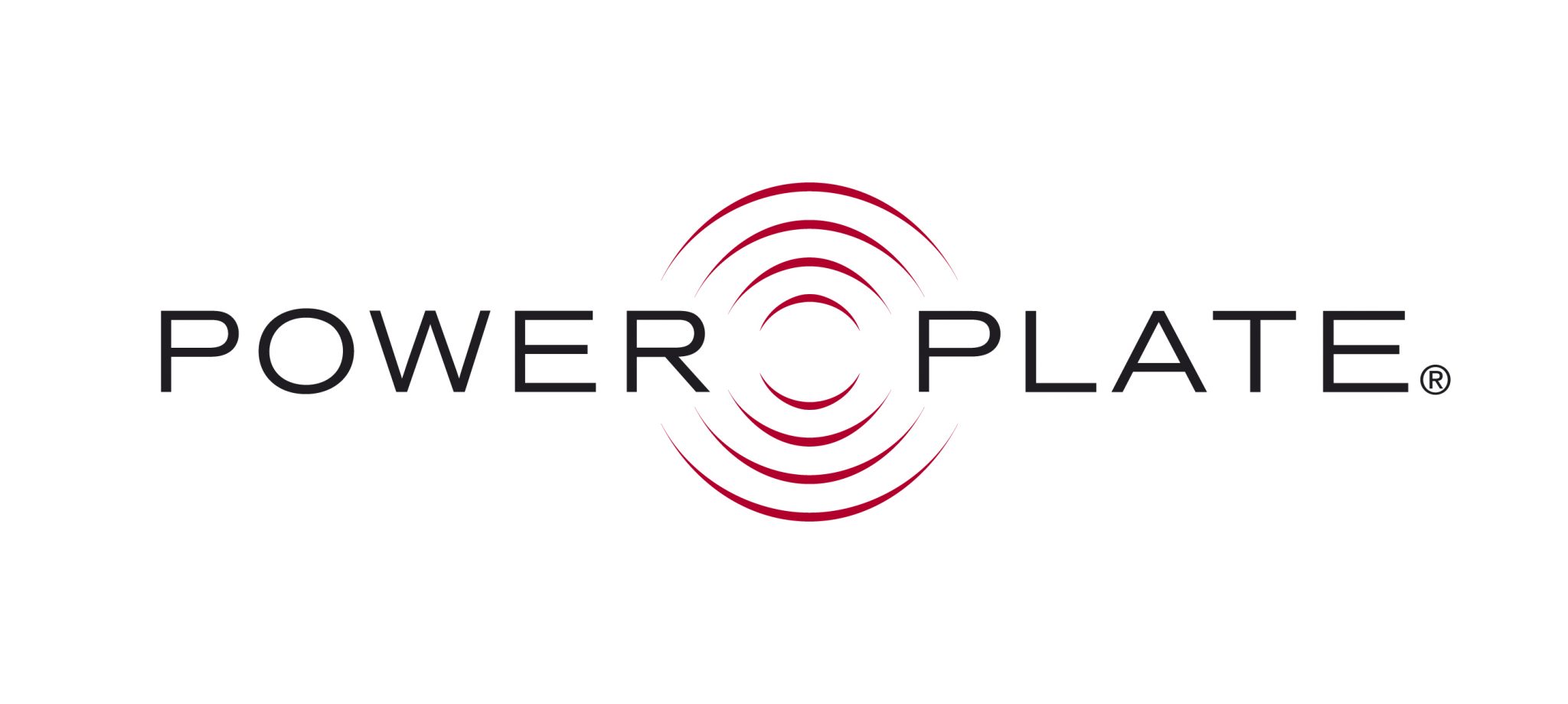




 There are those that utilized it when it first came onto the market, but were never really educated on how to use it. There are those that have never been near the Power Plate because they thought it was more of a gimmick than a medical grade training instrument. Finally, there are those who have never seen it before.
There are those that utilized it when it first came onto the market, but were never really educated on how to use it. There are those that have never been near the Power Plate because they thought it was more of a gimmick than a medical grade training instrument. Finally, there are those who have never seen it before.